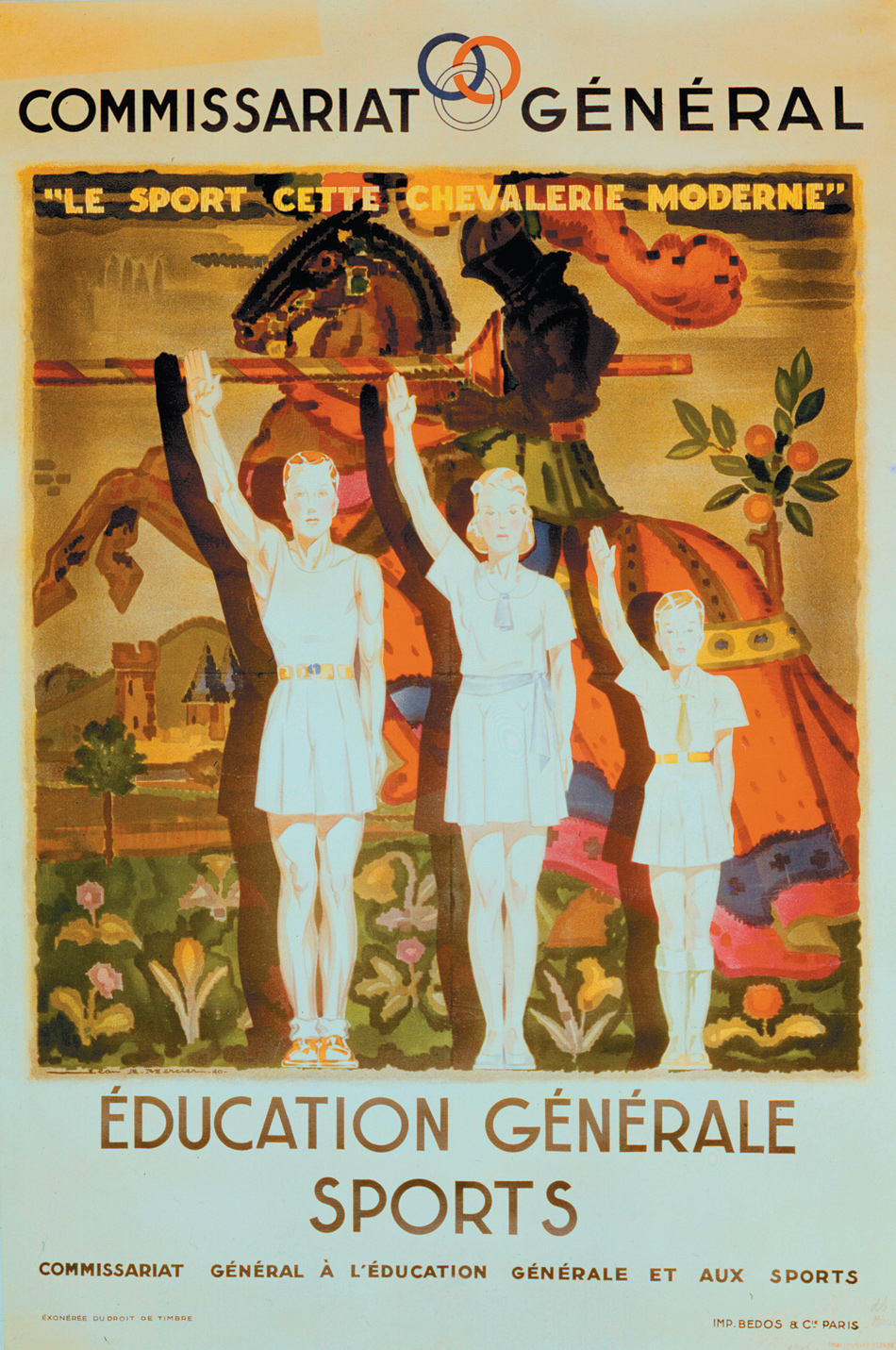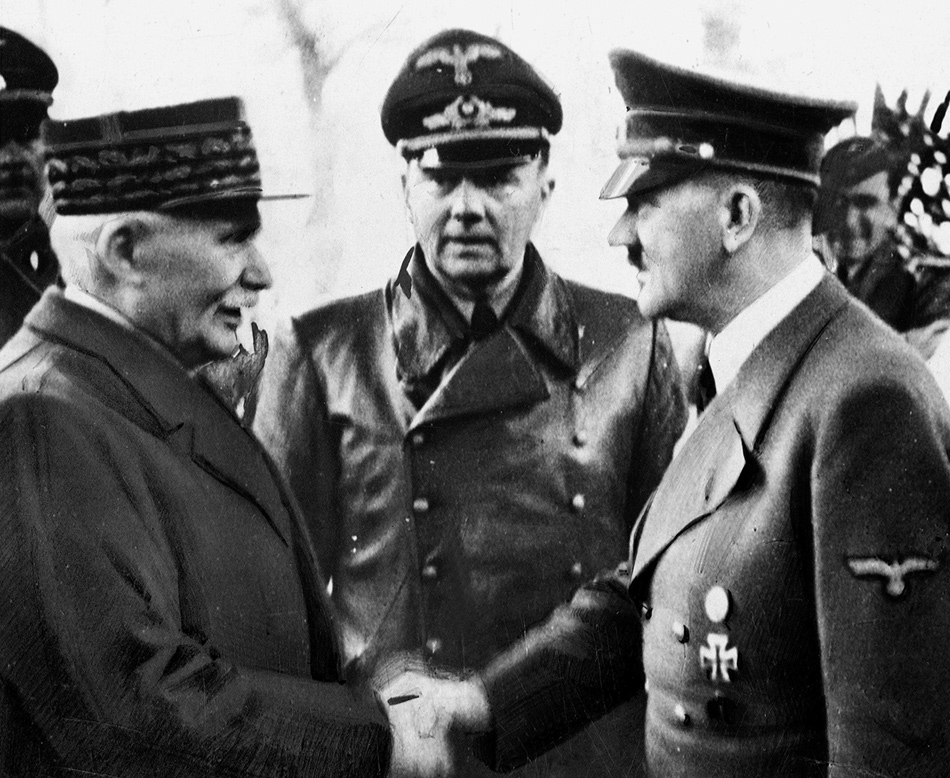L’Héritage de Vichy is an unconventional work—more a catalog of curiosities than a regular book. It advances a strong claim: that contemporary France still bears today many traces of the Vichy regime that governed under German occupation from 1940 to 1944. Cécile Desprairies proceeds item by item—vaccination, for example, or television—showing for each one, aided by contemporary photos and texts, what its situation was in 1939, how Vichy dealt with it, and what part of Vichy’s actions remained in effect after 1944. She offers, however, only the sketchiest general analysis of what continued, what didn’t, and why.
Desprairies’s main message is surprise. Isn’t it odd, she seems to say, how many traces remain of the Vichy experiment. One had believed it discredited by collaboration with the Nazi occupiers, swept away by the Liberation of 1945, and buried by the postwar transformation of French society during the Trente Glorieuses years of economic expansion. The brief preface by the celebrated historian Emmanuel Le Roy Ladurie, “Moi et Vichy,” strikes a similar note. He mainly lists survivals he found unexpected. Although Le Roy Ladurie alludes to his father Jacques, who served as the Vichy minister of agriculture in 1942 before joining the Resistance, he avoids raising any sensitive issues of general interpretation.
Surprise is not really warranted, however. The historiography of Vichy France since the 1970s has consisted largely of refuting the early postwar view that Marshal Pétain’s regime was an alien import imposed for the moment by Nazi force. Recent historians have reinstated Vichy firmly within the continuities of French history. Vichy France reacted to what had gone before, especially to the Popular Front of 1936, and tried to prepare for a postwar world that it believed was just around the corner. Historians have abundantly analyzed the breaks and continuities in France across World War II—what was radically changed in 1940 and again in 1945, and what went on very much as before. The breaks were exceptionally sharp at both turning points, but there were authentic continuities of personnel and of institutions, especially in technical matters. The contribution of Desprairies lies not in the idea that Vichy had a heritage but in the richness of her often fascinating details.1
Vichy’s legacies fall mainly into two categories: technocratic modernization and social welfare. The first category is the largest. The late Third Republic had woefully neglected French infrastructure, along with a host of unresolved political, social, and economic problems. The contraction of the French economy in the 1930s is sometimes attributed to the Third Republic’s weak executive, deadlocked parliament, and ideological divisions. The essential reason (one too often ignored by historians as well as by the public) was the economic policy of deflationary budget-cutting with which French leaders confronted the Great Depression until 1936. Even then, when the Popular Front government of Léon Blum proposed to take a different economic tack, it was prevented by divisions within its tenuous majority from embarking seriously upon needed public expenditures. The final decade of the Third Republic was therefore a period of extensive disinvestment.
The Vichy regime profited greatly from its claim to reverse this trend, to break the deadlock of the 1930s, and to get something done. In the aftermath of the calamitous defeat of 1940, many French people accepted an unfettered executive authority—where engineers and technical experts replaced despised parliamentarians in devising solutions—as the best way to address France’s problems. Vichy’s supposed fresh start beguiled many members of the French elite at first, before growing Nazi domination undermined its legitimacy.
In its opening days, therefore, Vichy was deeply engaged in modernizing French infrastructure and public administration. Desprairies points to the périphérique, the ghastly superhighway that encircles Paris, the backdrop, when it was new, to Jean-Luc Godard’s dystopic New Wave film Alphaville (1965), and today an obstacle course dreaded by airport-bound travelers. The Third Republic had begun to plan it, but, typically, had accomplished little. The Vichy government finalized the périphérique’s route, acquired the land, and undertook some construction before the materials were redirected to the building of the Atlantic Wall in 1943.
Desprairies could have offered many more examples of technical modernization undertaken in Vichy’s first optimistic months. When the translation of my Vichy France was being prepared in 1972, the French publishers prudently commissioned a team of young historians to fact-check what struck some advance readers as a suspicious and iconoclastic manuscript. The young historians wrote me in some agitation: How could I possibly claim that the great suspension bridge across the Seine at Tancarville, near Rouen, had been begun by Vichy and had initially been called the Marshal Pétain Bridge? How could I say that Vichy had laid down the keel of the transatlantic ocean liner known later as the Flandre (we students bound for Paris around 1960 liked to call it “the Flounder”) and that it was originally to have been christened “Le Maréchal Pétain”?
Advertisement
It was a simple matter to confirm these facts by sending photocopies of a few press clippings to the young historians. The list of Vichy’s technical projects could go on: the pioneering tide-operated electric power plant (l’usine marémotrice) on the Rance River estuary, in Brittany; the first link of the Trans-Sahara Railroad (the “Méditerrannée-Niger”) begun in Algeria in 1941, intended to reach Bamako (Mali) and Dakar. Vichy’s Ministry of Industrial Production prepared detailed plans for the modernization of the French economy, and Richard Kuisel showed years ago that the team around Jean Monnet that reconstructed France after 1945 relied heavily on them at first.2
Vichy also embarked on the first serious administrative rationalization of France since Napoleon. It overlaid the 1790s grid of ninety departments, made too small by easy travel in automobiles and buses, with a new grid of seventeen regions, each headed by a regional prefect charged with economic and security matters. It replaced the patchwork of French municipal police agencies with a national police force. The regions, greatly strengthened, and the national police remain in place today. Vichy instituted the identity cards still in use. It coordinated the Paris bus and subway systems into the single mass transit system we know today, and extended some of the subway lines further into the suburbs (something Americans might envy).
A second broad category of survivals from Vichy consists of programs of social and medical assistance. The Vichy regime was a welfare state.3 L’Héritage de Vichy serves as a useful reminder that the welfare state was not originally a socialist or Communist project. It was introduced into European political life from the right, first by Bismarck, with sickness and accident insurance in imperial Germany in 1883–1884, and emulated by Count Eduard von Taaffe in the Austrian Empire in 1887. Bismarck had just outlawed the German Social Democratic Party, and his intention was to eliminate its reason for being as well as to consolidate a paternalist and statist social order. Continental European Marxists opposed piecemeal welfare measures as likely to dilute worker militancy without changing anything fundamental about the distribution of wealth and power. It was only after World War II, when they abandoned Marxism (in 1959 in West Germany, for example), that continental European socialist parties and unions fully accepted the welfare state as their ultimate goal.
In Britain, the foundational acts of the welfare state, the Old-Age Pensions Act of 1908 and the National Insurance Act of 1911, came not from above, as in Germany, but from broad popular disgust with the inadequacies and arbitrariness of the 1834 Poor Law. These acts were the work of the Liberal Party, and particularly of Chancellor of the Exchequer David Lloyd George, who made a conscious effort to forestall more costly Labour Party proposals for tax-supported relief programs rather than ones financed by workers’ and employers’ payments.4 Workers generally objected to social support programs to which they were expected to contribute (as many Americans conclude when they have to deal with Social Security for household workers).
All the modern twentieth-century European dictatorships of the right, both fascist and authoritarian, were welfare states. The current American conservative agenda of a weak state associated with laissez-faire economic and social arrangements would have been anathema to them, as an extreme perversion of a despised individualistic liberalism (in that term’s original sense). They all provided medical care, pensions, affordable housing, and mass transport as a matter of course, in order to maintain productivity, national unity, and social peace.
Some of them, more innovatively, even provided recreation for their citizens, through, for example, the Nazi Party’s Kraft durch Freude (Strength through Joy) program and the Italian Fascist Dopolavoro. But they provided these benefits in a paternalistic way, simultaneously eliminating any kind of independent worker power strong enough to produce what workers really wanted—higher wages and shorter hours.
They also abolished independent trade unions and the right to strike (here they would have found common ground with the contemporary American right). But they did not take the risk of leaving the poor in solitary misery. They replaced unions with “corporatist” committees composed of both workers and managers empowered to deal with workplace issues (though without any say in management). Then they felt free to lengthen hours and squeeze wages.5
Vichy France did the same. Marshal Pétain denounced the evils of unfettered free-market capitalism in a speech at the industrial city of Saint-Étienne on the regime’s new Labor Day, May 1, 1941. His government instituted old-age pensions, which had been discussed endlessly under the Third Republic (“I keep promises, even those of others,” he said). Pétain’s government established the first French minimum-wage legislation. It greatly expanded access to medical care by instituting obligatory medical visits in schools and by attaching medical inspectors and labor inspectors to factories. It put into effect the first obligatory vaccination program in France. It tried to reduce alcohol consumption, and a poster prohibiting the sale of alcohol to children visible in French bars today is a legacy of these efforts.
Advertisement
Desprairies can easily demonstrate that the Fourth Republic retained these programs and greatly expanded them. But they had worked in peculiar ways under Vichy. The minimum wage, for example, came into being as an aspect of wage control, a matter in which the German occupation authorities intervened directly. Vichy’s efforts to revive artisanal production and organize and rationalize the professions were accompanied by the exclusion of Jews. Administrative rationalization was meant to strengthen the regime’s capacity to repress the Resistance. The workers on the Trans-Sahara Railroad included Spanish and Jewish refugees impressed from refugee camps.
The problem is not that Desprairies’s case studies are erroneous; she has done a good bit of homework about the details. But they lack context. Her format of listing reforms and showing their heritage might suggest to an unwary reader that Vichy’s modernization and social welfare measures passed inertly like furniture from one regime to another. The reader needs three large perspectives to make these survivals more than a catalog of curiosities.
The first perspective is German pressure, and in fact Desprairies is fully alert to it. The German occupying authorities were interested in getting a maximum of yield out of the French economy. So they intervened in working conditions. They were also interested in bringing the glories of German culture to the benighted French. I was surprised myself to learn that Mozart had been little played in France before 1940, and that his prominence since 1945 in the French operatic and symphonic repertoire is one of the legacies of the occupation.
A second perspective, French politics, is less visible in Desprairies’s approach. Most of what was done by Vichy was poisoned from the beginning by the French right’s zeal to exact revenge for the “Judeo-Masonic” Popular Front of 1936. Many of the projects undertaken by Vichy were given a peculiar meaning by the regime’s authoritarian structure and reactionary priorities, and by Vichy’s own decision—independent at first of Nazi pressure—to reduce the role of Jews in French economic and cultural life. So we are not dealing here with simple continuities in which a program passes unaltered from Vichy to the Fourth Republic.
Desprairies deals well with the different meanings of sport before and after 1940. Sport was encouraged both by the Popular Front and by Vichy but for different purposes: for hygiene and public welfare in 1936, and after 1940 for national revival. Her discussion of the creation of a national police force is illustrated by an appropriate photo of French gendarmes kicking in the door of a supposed Resistance hideout. Desprairies might have illuminated even more often the dark underside of Vichy’s reforms.
The third essential perspective is time. Vichy’s early modernizing aspirations were a false dawn. They became distorted when after June 1941 the Nazi grip intensified into full-scale economic spoliation to support Hitler’s gigantic war in the East. Then came the extension to France of the Final Solution of the “Jewish problem” that implicated Vichy in crimes against humanity, and the rise of the Resistance that Vichy dealt with by transforming itself into a police state.
Vichy purchased its survival as a quasi-sovereign state by assisting Hitler’s war in the East and by preparing to participate in his New Europe that would be, among other things, Judenrein. Most of the Vichy programs that were continued after the war dated from the first eighteen months following France’s defeat, the period of the “new start.” These (if we don’t mention Vichy’s own measures against Jews and the left) could sometimes look like rational solutions to French problems. But by the end of 1942 the intensification of the war meant that Vichy’s “new start” was barely a memory.
Another disadvantage of Desprairies’s approach is that some major legacies of the occupation years are not easily reducible to items on a list. The French economy emerged from the war more centralized, more organized, and with larger firms—due in part to German orders, in part to Vichy’s drive to rationalize, and in part to the demands of postwar reconstruction. The position of the Catholic Church within French society changed profoundly during World War II, but the church never appears in this book. Vichy’s aid to Catholic schools was continued by the Fourth Republic, in which a new Catholic party with advanced social ideas—the Mouvement républicain populaire—shared power, and where the Third Republic’s old anticlericalism seemed outmoded after some Catholics and Communists had made common cause in the Resistance. General de Gaulle himself exemplifies the strength of social Catholicism in postwar France. Despite his utter refusal ever to accept the Vichy regime’s legality, he judged at the end of his life that some of its social doctrines such as corporatist cooperation between labor and management and support for large families were “not without appeal.”6
Vichy’s “worker priests” (sent initially to minister to French factory workers conscripted to German factories) were adopted by the Catholic left after the war until the Vatican closed the experiment down in the 1950s. Desprairies also omits the remarkable turn upward during the war of the French birthrate, which still sets France apart from much of the rest of Europe, although she mentions the policy of state aid to large families, begun by the Third Republic, accentuated by Vichy, and continued to this day. Such complex matters, where Vichy’s actions combined with multiple lines of causation to shape the heritage of the war and occupation period, are largely invisible in this book.
Desprairies does not seem to have set out overtly to whitewash the Vichy regime. When Vichy’s exclusionary measures come into view, she stoutly condemns them, as in her essay on the new organization of the medical profession (l’Order des médecins, which still exists), in which she shows that it helped the government eliminate foreign Jews and limit the number of French Jews in the medical profession. But they don’t come into view as often as they might because the continuities of welfare and other measures following the war mostly concern matters of ordinary existence. Focusing on the continuities has the effect, intended or not, of making Vichy look more benign.
Students of Nazism made this discovery when they experimented in the 1980s with Alltagsgeschichte, the history of everyday life. In this perspective, the Nazi anti-Jewish pogrom faded into the background, while a different set of victims—housewives confronted by rationing and scarcities, families who lost their homes to Allied bombing—came to center stage. Similarly, Desprairies’s perspective of heritage omits ugly matters like Vichy’s purge of socialists and Freemasons altogether; and the exclusion and persecution of Jews, while not ignored, tends to remain offstage. Unless we supplement this work with a more rounded treatment we risk getting a falsely benevolent impression of the Vichy regime.
This Issue
April 25, 2013
Scientology: The Story
A Digital Library for All
-
1
See Julian Jackson’s finely nuanced essay on change and continuity entitled “A New France?” that closes his superb France: The Dark Years, 1940–1944 (Oxford University Press, 2001). ↩
-
2
See Richard F. Kuisel, Capitalism and the State in Modern France: Renovation and Economic Management in the Twentieth Century (Cambridge University Press, 1981), pp. 155, 200–201. ↩
-
3
See Philippe-Jean Hesse and Jean-Pierre Le Crom, La Protection sociale sous le régime de Vichy (Presses Universitaires de Rennes, 2001). ↩
-
4
See E.P. Hennock, The Origin of the Welfare State in England and Germany, 1850–1914: Social Policies Compared (Cambridge University Press, 2007), pp. 217–218. ↩
-
5
Since European fascist and authoritarian states combined social welfare measures with low wages and low consumption, their form of the welfare state differed profoundly from the consumption-driven Keynesian model. See a slightly different typology in Gøsta Esping-Andersen, The Three Worlds of Welfare Capitalism (Princeton University Press, 1990). ↩
-
6
General De Gaulle, Mémoires de guerre, Vol. III. Le Salut, 1944–46 (Paris: Plon, 1959), pp. 94–95. ↩





